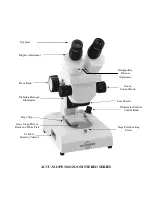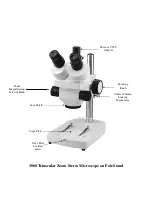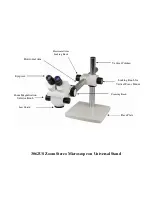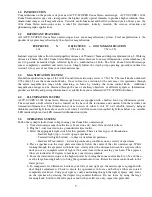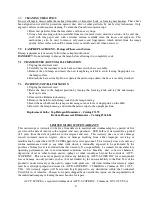
5
1.0 INTRODUCTION
Congratulations on the purchase of your new ACCU-SCOPE® Zoom Stereo microscope. ACCU-SCOPE’s 3061
Zoom Stereo microscope series incorporates the highest quality optical elements to produce high resolution, three-
dimensional images at all magnifications. Versatile, multi-functional and built to withstand years of heavy use, the
3061 Zoom Stereo microscope series is ideal for electronics, industry, research, life science, education and
photomicrography applications.
2.0
IMPORTANT FEATURES
All ACCU-SCOPE® Zoom Stereo microscopes have zoom magnification systems. Total magnification is the
product of eyepiece magnification by the objective magnification:
EYEPIECES X OBJECTIVES = ZOOM MAGNIFICATION
10x 0.75x to 3.5x 7.5x to 35x
Inclined eyepiece tubes allow for interpupillary distance of 55mm to 75mm and diopter adjustment of ±5. Working
distance is 80mm. The 3061 Zoom Stereo Microscope Series feature a four-way illumination system which may be
used to provide transmitted light, reflected light or a combination of both. The 3061 Zoom Stereo Microscope
comes completely assembled and ready to use. Simply follow the step-by-step operating procedure outlined in
section 5.0 for years of use from your stereo microscope.
3.0
MAGNIFICATION SYSTEM
Standard magnification range of the 3061 Zoom Stereo microscope series is 7.5x-35x. The small knobs numbered
0.75x thru 3.5x are the zoom control knobs. Once in focus (see section 6.0) the user may view specimens through
the entire magnification range while remaining in focus by rotating the zoom control knob. Additional
magnification ranges can be obtained through the use of auxiliary objectives or different eyepieces. Information,
product availability and pricing information is available from your authorized ACCU-SCOPE distributor.
4.0
ILLUMINATION SYSTEM
ACCU-SCOPE’S 3061 Zoom Stereo Microscope Series are equipped with a built-in, four-way illuminator system.
The convenient on/off selector knob is located on the base of the instrument and controls both the incident and
transmitted illumination. The illumination system consists of either 6 volt 15 watt variable intensity halogen
dichrohic incident light from above and a cool white 5 watt fluorescent transmitted light from below or a variable
LED incident light and an LED transmitted illumination system.
5.0
OPERATING SYSTEM
Follow these simple instructions to begin using your Zoom Stereo microscope:
1.
Your stereo microscope should always be used on a dry, hard, flat and stable surface.
2.
Plug the 3-wire line cord into a grounded electrical outlet.
3.
Select the appropriate light switch for the specimen. There are three types of illumination:
-
Incident Light (top) – to view opaque specimens
-
Transmitted Light (bottom) – to observe translucent specimens
-
Incident & Transmitted - to develop contrasting conditions on any variety of specimens
4. Place a specimen on the stage plate area directly below the center of the stereo microscope. While
looking through the eyepieces with both eyes, slowly adjust the distance between the eyepiece tubes
until you see a complete circle of light at the same time without moving your head. The eyepiece
tubes are inclined at 45 degrees to maximize your viewing comfort.
5. Focus the stereo microscope at the highest power by turning the zoom control knob to 3.5x and then
use the large focusing knob(s) to bring the specimen into focus. Rotate the zoom control knob to the
lower powers.
6. To compensate for differences between your left eye and right eye, the microscope is equipped with
dual diopter adjustments. Check to ensure the specimen is in focus and both eye tubes are rotated
completely clockwise. Using your right eye only and looking through the right eyepiece only, focus
on the specimen by rotating the diopter ring counterclockwise. Do not focus by using the large
focusing knob. Switch to the left eyepiece and with your left eye only, repeat this procedure.
Summary of Contents for 3061 Zoom Stereo Series
Page 1: ......


